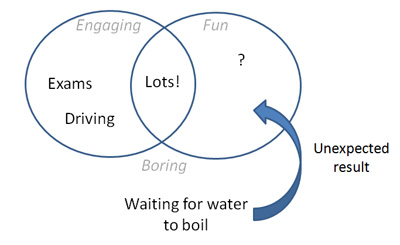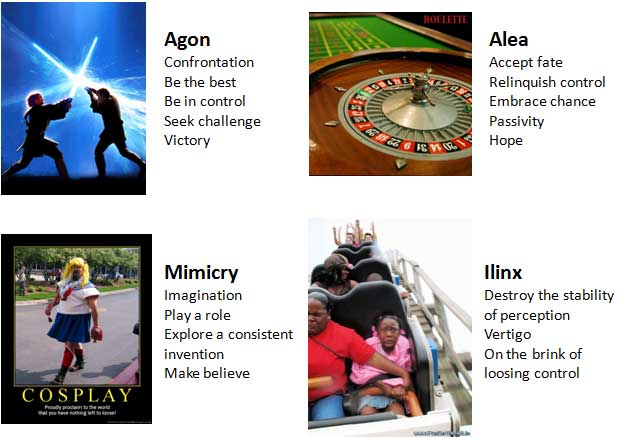Trending
Opinion: How will Project 2025 impact game developers?
The Heritage Foundation's manifesto for the possible next administration could do great harm to many, including large portions of the game development community.

Featured Blog | This community-written post highlights the best of what the game industry has to offer. Read more like it on the Game Developer Blogs or learn how to Submit Your Own Blog Post
Providing fun is the objective of every game and better understanding it is key. A research paper from Alan Dix and Masitah Ghazali explores uncertainty as a key component of fun. Here is my opinion on how it relates to game design.

This article was originally posted on my personal blog and was recently cited by Dan Taylor in his post Ten Principles of Good Level Design - Part I, so I felt like sharing it here.
-----
 “Have you found the fun yet?” is a question we often hear asked to designers. It shows how shallow is our understanding of the craft of games, but also how easily we accept such a vague mandate. Trying to help the fine folks at Relic to develop a better acquaintance with that elusive concept led me to some interesting finding that I want to share with you with the hope that it will make the designer job more focused and that it will help those that manage them provide guidance and evaluate the results.
“Have you found the fun yet?” is a question we often hear asked to designers. It shows how shallow is our understanding of the craft of games, but also how easily we accept such a vague mandate. Trying to help the fine folks at Relic to develop a better acquaintance with that elusive concept led me to some interesting finding that I want to share with you with the hope that it will make the designer job more focused and that it will help those that manage them provide guidance and evaluate the results.
The first step on that road was when I stumbled upon “Fun systematically”, a paper from Alan Dix that recounts his efforts with Masitah Ghazali to explore the boundaries between engagement and fun. They focused on experiences that were neither fun nor engaging – in the boring zone – and used the technique of mutation to figure out what ingredient to add to turn a boring experience into a fun one, without it becoming engaging. Their example is the pretty boring activity of waiting for a kettle to boil. Dix found out that adding the surprise effect of a bird that pops up and sings when the kettle boils brings fun to the activity. It actually seemed pretty obvious, uncertainty was the key ingredient.

Alan Dix' mutation process to create fun
Surprise would bring playful excitement to an experience. Later on, a report came out of Starcraft 2’s Dustin Browder saying that they had decided to keep the infamous “six-pool” tactic – putting all your resources into the cheapest attack units to quickly overrun your opponent before he can develop – because the uncertainty it brought created a fun experience. That encouraged me to explore the idea of uncertainty as a source of fun and this is how that journey went for me.
Let’s first analyze the fun that comes from the great game of Tic-tac-toe. In turn, the game asks players a question: Where do you want to play your mark? The lack of certainty on which move is the best is what creates intense trepidation and fun, at least for young children. Of course there are so few meaningful possibilities that after a few rounds, it is possible to basically decode the whole game and understand the dominant strategy and the optimal counter. Interestingly, the moment you realize the whole game is known and there are no ways to trick or be tricked, the game ceases to be fun and you move on to another activity. One could advocate that you might want to keep playing to enjoy winning over an opponent that hasn’t fully understood game, but I would actually say that this is pleasure that you would be after, and not fun (see Pleasure without learning leads to addiction for more on the distinction). As we will see later on, enjoyment can come from a stable state and one can find pleasurable an easy-going activity, but as it implies learning and development, fun requires an active attitude of seeking and confronting challenge.
Also read: Pleasure without learning leads to addiction – Learning is the distinction between pleasure and fun.
The need for uncertainty is obvious in the case of abstract games with discrete states, but I believe that its appeal also translates into analog activities. Think of the evolution of fun as you learn how to ride a bicycle. The first few strides on a bike are mainly about getting used to the overall experience, everything is new and unknown, the discovery maximum: Speed, inertia, the wind on your face, the different movements and muscles involved … As soon as you master your ride enough not to be in danger, the experience is fun. Then you start controlling your ride better, and as you do, the excitement starts dropping. This is usually the moment your stab wheels are removed. That new level of complexity renews the experience and you are now enjoying the challenge of balancing your ride. But as you start to master these new conditions and exit the challenging zone, your bicycle stops being a challenge to use, and it starts becoming a boring mean of transportation. As you master its instability, it ceases to represent uncertainty and thus ceases to be fun. As further proof, common behaviors to make it fun again from that stage of mastery can be increasing speed out of your comfort zone, standing on the frame of your bike to make balance harder to control, or breaking abruptly to drift.

The low level analysis of this phenomenon is an interruption of adherence as a result of a turn. I consider the fun of it to come from the sudden change of behavior of my bike as it starts to skid with a slight incertitude on when the bike will resume adherence and change back to its normal physics. At the atomistic level, there is a sudden change in behavior, with uncertainty on when it will revert back to normal.
Actually, drifting is a perfect illustration of uncertainty applied to platformers like Super Mario Bros., as an expression of inertia. This game is all about controlling your Italian plumber through an obstacle course. There is a main problem though, as the physics of Mario make it hard to control. You don’t reach top speed immediately, you can’t stop on the spot neither, even worse is your airborne control as you try to steer in mid-air. In these conditions, evaluating the speed and timing to perform your jumps across deadly pit is uncertain, which is also why they are fun. The core activity in a game must be challenging if you want it to be fun.
The common adage is that you want controls to be tight, but I would actually advocate that in these precise circumstances, you want them to be loose, enough that they produce consistent but hard to predict results of.
The idea of balancing challenge and skill is quite reminiscent of Csikszentmihalyi’s theory of Flow, except that this concept is particularly suited to describe a state of total immersion in a given task, leading to optimal and effortless results in the accomplishment of a task. Of course if the subject is actually doing work, then you want him to be in a stable state of balance between the difficulty of his task and his skill level. That way, his concentration is maximal, his perception of time diminishes and he’s likely to go through his assignment quickly and efficiently. On the contrary, for a game experience to be fun, it requires highs and lows in the perception of challenge, as that’s the best way to acknowledge one’s progression in skill and thus alternate between the process of increasing them, and the actual enjoyment of the acquired capacities.

Flow (left) is adapted to task completion and thus requires stability, while Fun (right) is in the realm of entertainment and is experienced when on the fringe of comfort.
Csikszentmihalyi defines the “flow channel” by the zone where the skills are adapted to the challenge. If we agree that fun is experienced when exploring uncertainty and learning from it, then we need to consider the upper fringe of the flow channel, where anxiety appears, to be the zone where fun can be experienced. As players get at ease under increased challenge, their skills increase and they go back in their comfort zone. They may actually ride the flow channel, enjoying their new acquired mastery. But as this feeling gradually dissipates, they might exit the flow channel by the bottom and enter the boring zone where they don’t feel challenged enough. This is where an adventurous player may then consider upping the ante and go after more complex challenges, or if he feels like it’s not worth the effort or if new accomplishments don’t seem available, the player might decide to quit playing all together. A more competitive player will probably rarely indulge back to the boring zone and seek one challenge after another, but the main idea is that while flow is about remaining in the balance zone, the seeking fun is a more dynamic back and forth that aims at the fringe of the flow channel.
Everyone doesn’t immediately relate to the research of challenge as describing how they seek fun. This is mainly due to the fact that we tend to associate challenge with left-brain activities like math, logic or puzzle-solving while there are many different ways to challenge ourselves and enjoy progression. As Nicole Lazzaro and Richard Bartle explain, there are different reasons why we play games, different ways to enjoy them, which leads to different player types. Let me tag in my personal buddy on that field: French sociologist and philosopher Roger Caillois. In his book “Man, play and games”, he broke down games in four core principles based on what people would seek in them. With chess as its epitome, Agon is about confrontation where you try to overcome a challenge based on your skills. Alea is the characteristic of games that rely on luck, like roulette. Illix comes from activities that would be sought after because they blur the perceptions and create vertigo, like roller-coasters. Finally, Mimicry is the roleplay or imitation of other characters or behaviors. Games can include elements of one or multiple of these categories, but it’s important to realize that they all require uncertainty to function as part of a game.

Roger Caillois’ four core game principles
Uncertainty about the outcome of a game are obviously required for Agon and Alea-based games. The enjoyment of Illix is intrinsically related to uncertainty through randomness. Even Mimicry requires the uncertainty of challenge to be interesting. Roleplaying yourself or your twin brother won’t be entertaining, and as you increase your acting proficiency, you might want to try roles that are more and more alien to you, similarly to successful actors that go for more risky parts later in their career.
Clearly, in games, it’s the uncertainty that makes the experience fun. A game gives you a problem that has to bear uncertainty in how to solve it whatever the nature of the skills involved. I also believe that the concept of uncertainty being at the core of fun also applies to other forms of entertainment. A good joke for example sets a pattern for your brain to follow, and then tricks you where you weren’t expecting it. As the punch line breaks context, your brain looses traction and spins helplessly before finally “getting it”. Same thing with a story, if everything is clear from the get go, and the plot never twists, you’re in for a pretty blend experience. Instead, most stories actually create expectation of troubled resolution by establishing clearly tense situations that have change and transformation written all over. I don’t know much about writing, but I think that as long as it stays coherent, the more unexpected the resolution, the more entertaining the story.
Someone recently called fun “boring”, but I think even worse of it. Fun is dangerous. It is dangerous to use as a mandate as it is so undefined that it is bound to lead to hit and miss that generally ends up in endless reworks involving whole teams in devastating time crunches. It needs instead to be analyzed and described as clearly as possible before moving too far into production.
So, understanding the fact that different people might have different motivations to play games I would propose the following statement.
Fun is the desired exploration of uncertainty.
We need to offer a type of exploration that will suit our audience, and define what uncertainty will be offered. I admit that it is not much, but I hope it at least helps focussing the discussion and will be the springboard for the next piece where we will analyse how to trace these paths through uncertainty, the creation of gameplay.
Also read: Understanding Gameplay – Part Two: Technique – How to apply this approach to creating gameplay.
My website - My Youtube channel - My Twitter
References:
Alan Dix and Masitah Ghazali, Fun systematically, link
Mihaly Csikszentmihalyi, Flow: The Psychology of Optimal Experience
Nicole Lazzaro, Chasing wonder and the future of engagement, link
Richard Bartle, Hearts, clubs, diamonds, spades: Players who suit MUDs, link
Roger Caillois, Man, play and games
Neils Clark, Fun is boring, link
Read more about:
Featured BlogsYou May Also Like